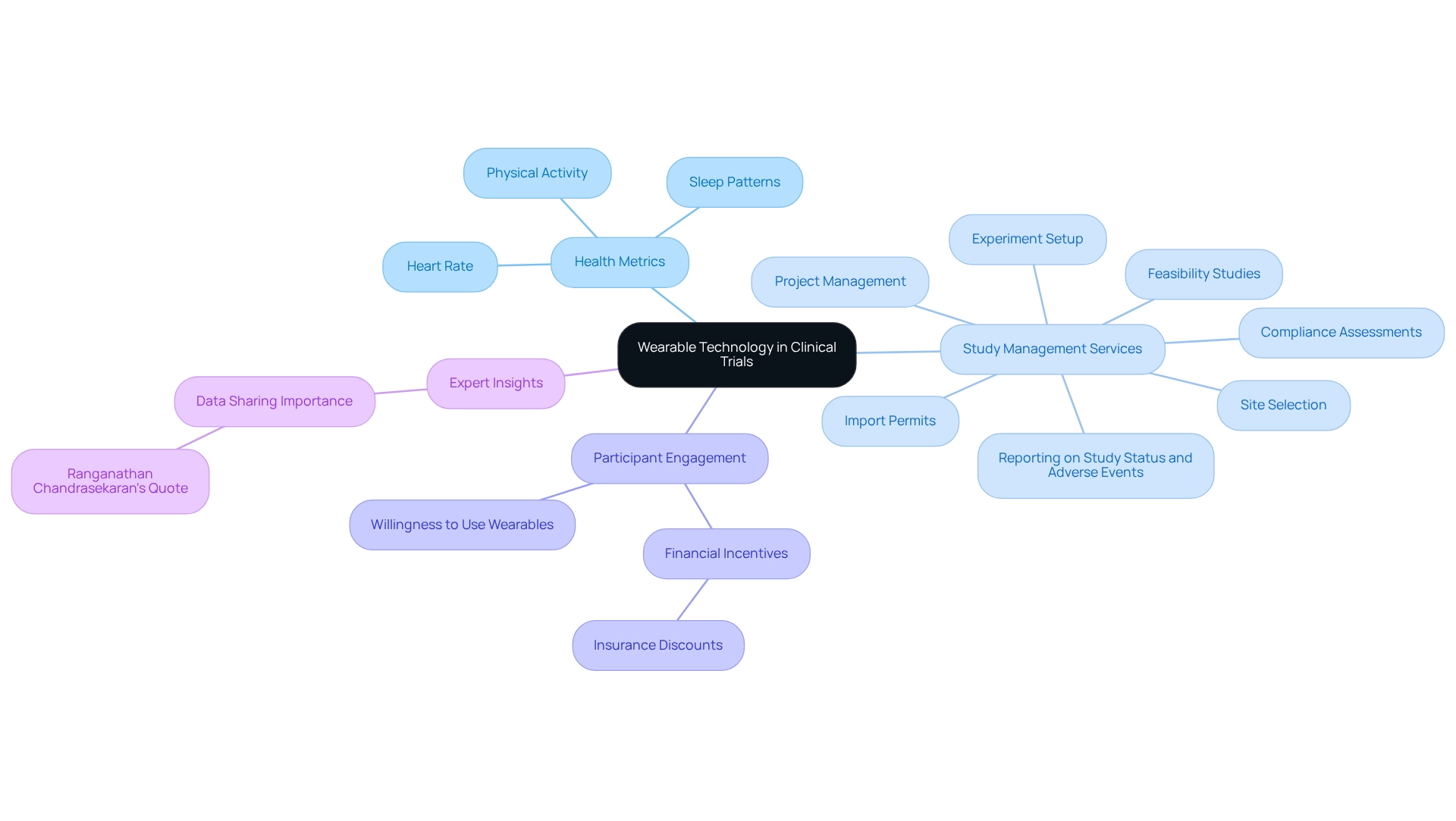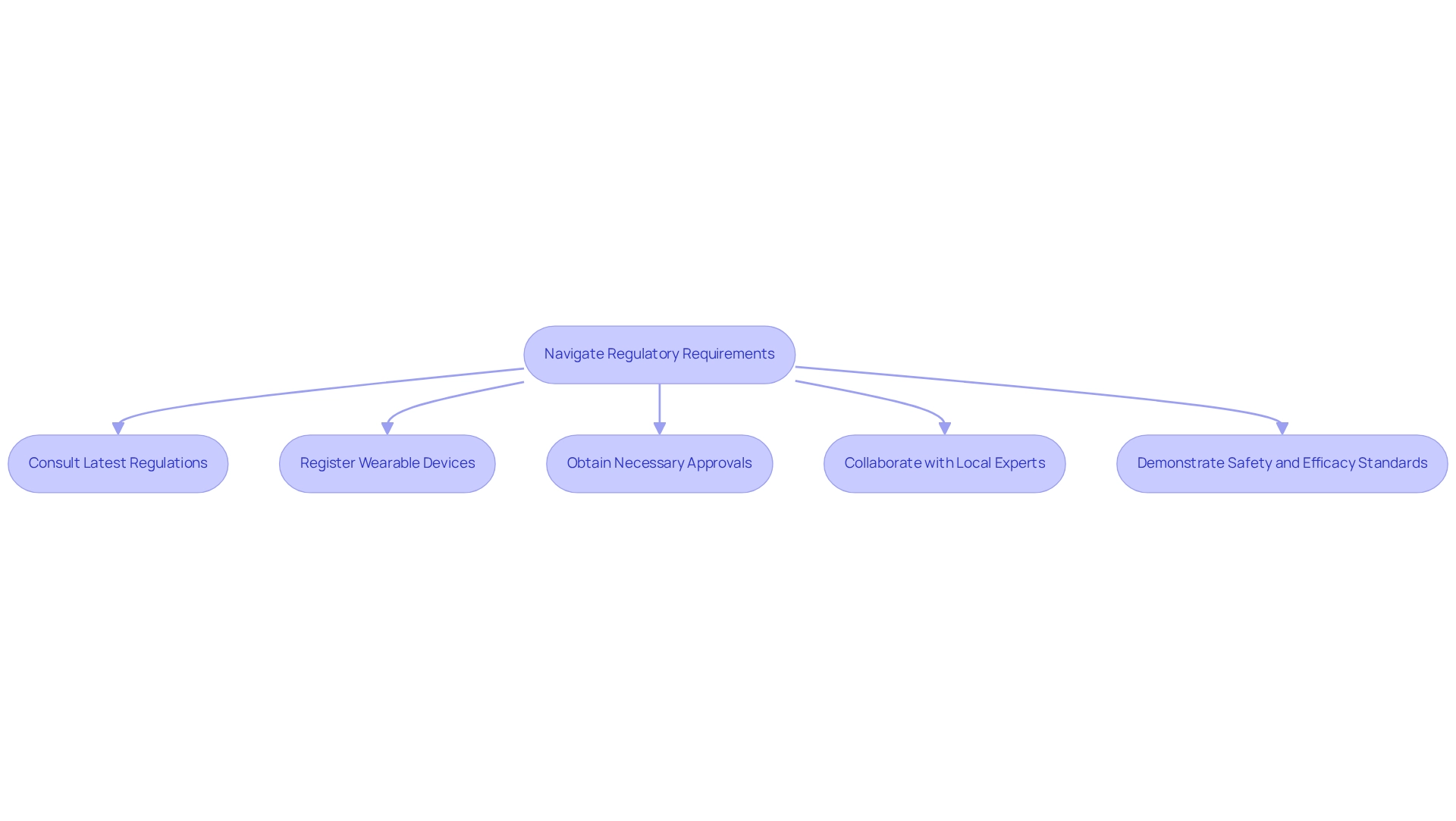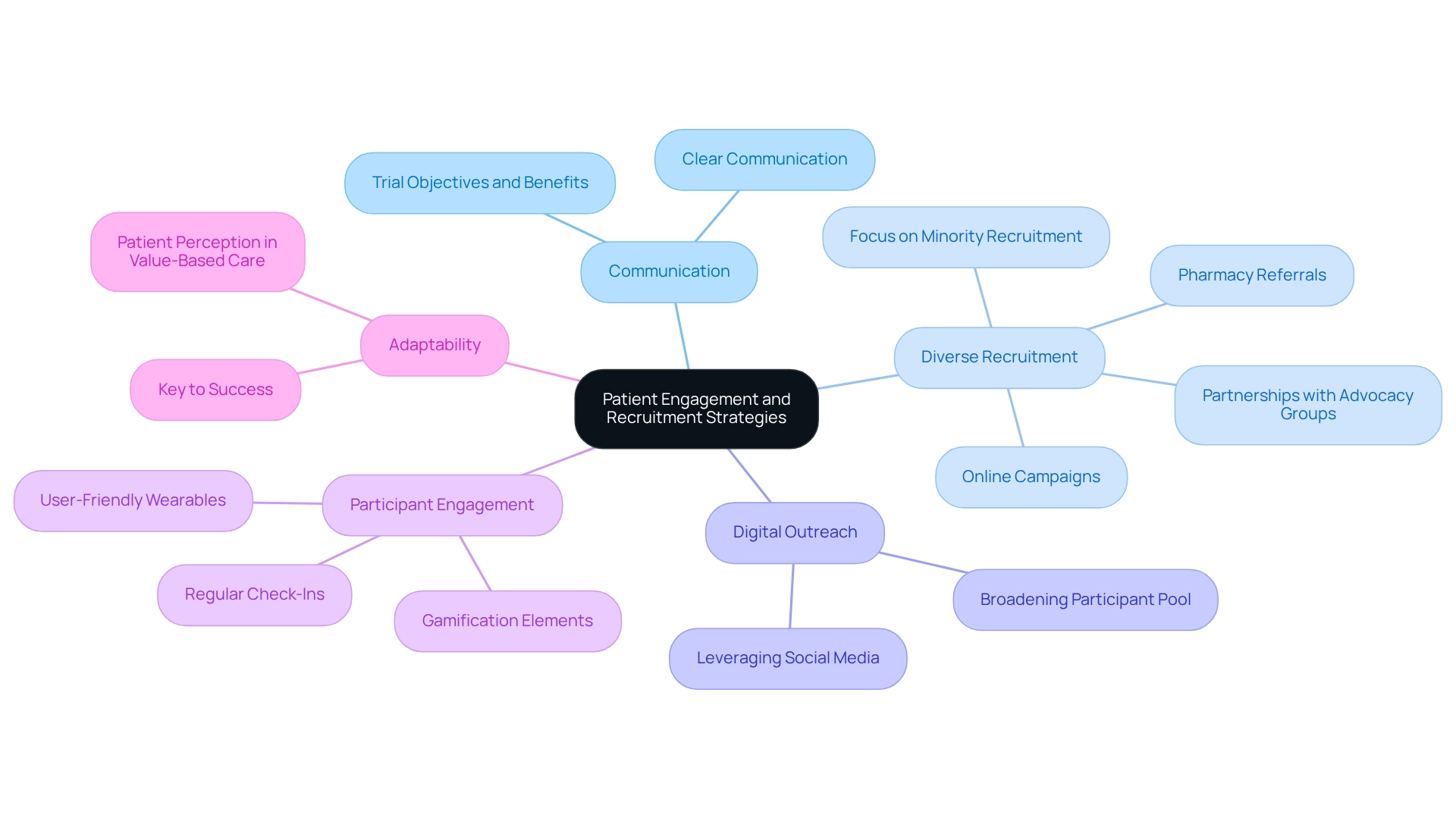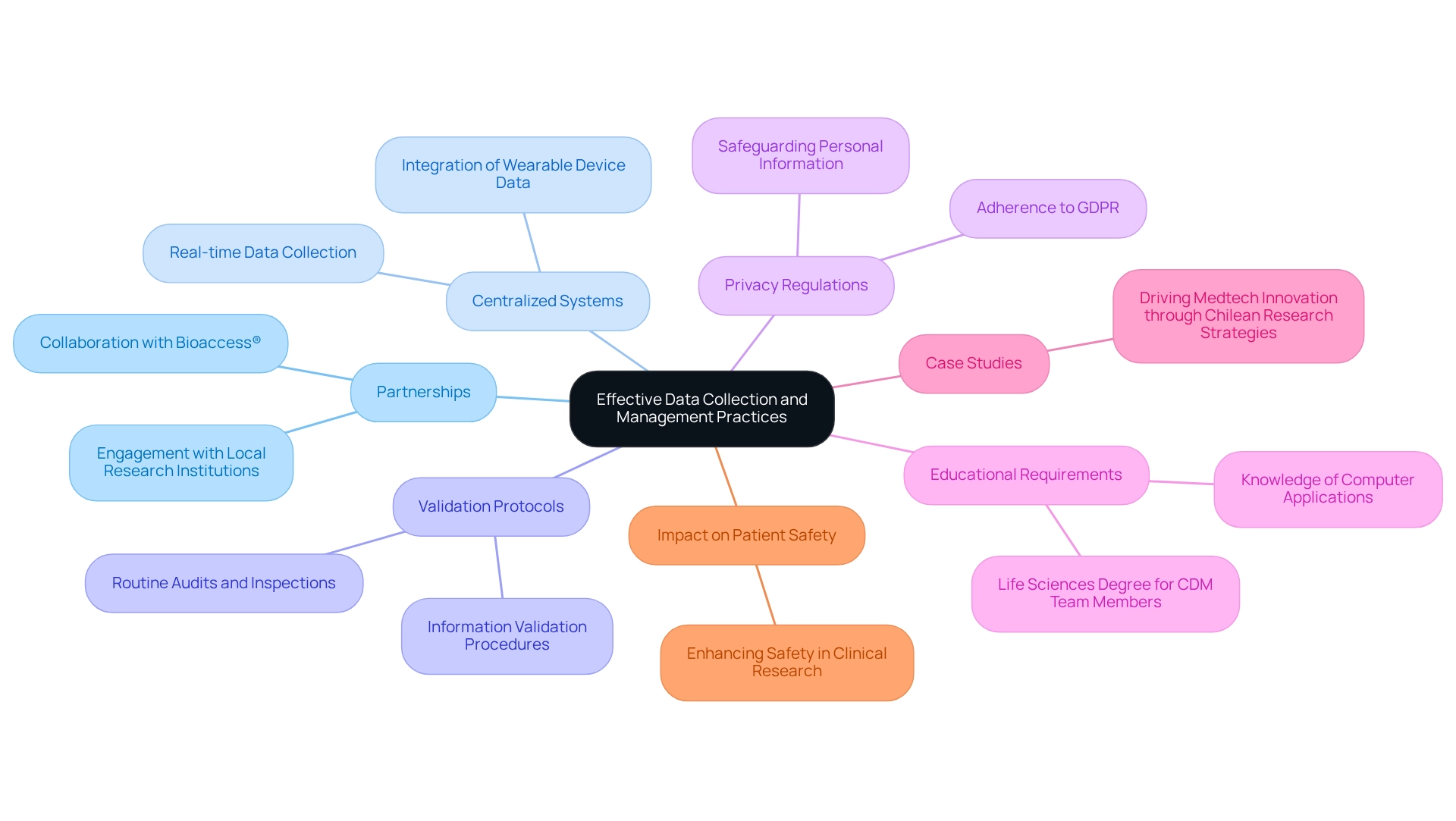Overview
Successfully designing trials for wearables in Ecuador necessitates a strategic approach that includes:
- Defining specific health metrics
- Adhering to regulatory requirements
- Implementing effective patient engagement strategies
This process is crucial for ensuring that studies are not only compliant but also relevant to the local context. Thorough planning and strict compliance with local regulations are paramount, as they enhance participant involvement and ensure reliable data collection in wearable technology studies. Furthermore, utilizing diverse recruitment methods is essential to attract a wide range of participants, thereby enriching the data collected and reinforcing the validity of the research outcomes.
Introduction
In the rapidly evolving landscape of healthcare, wearable technology is emerging as a pivotal force in clinical trials, presenting unprecedented opportunities for continuous health monitoring and data collection. Devices such as smartwatches and fitness trackers are more than mere trendy gadgets; they possess the potential to revolutionize how researchers assess medical interventions by capturing critical health metrics in real time.
However, the integration of these technologies into clinical research introduces a unique set of challenges, ranging from regulatory compliance to patient engagement. As the demand for personalized and effective healthcare solutions intensifies, it becomes essential to understand the role of wearables in clinical trials, particularly in regions like Latin America, to advance medical research and enhance patient outcomes.
Understand the Role of Wearable Technology in Clinical Trials
Wearable technology, including smartwatches and fitness trackers, is revolutionizing medical trials by enabling continuous health monitoring of participants. These devices gather essential health data, such as heart rate, physical activity, and sleep patterns, which are crucial for evaluating the effectiveness of medical interventions. Recent statistics reveal that only 4.5% of studies supported monitoring a previously diagnosed condition, underscoring the need for broader adoption of these devices in research to enhance patient outcomes and the quality of information.
To effectively integrate smart devices into clinical studies, researchers must first define the specific health metrics they wish to observe and select gadgets capable of accurately collecting this information. For example, a study concentrating on cardiovascular health could employ devices that track heart rate variability and physical activity levels. Understanding the strengths and limitations of these technologies is vital for designing studies that optimize their potential.
The increasing trend of financial incentives for device users, illustrated by a case study in which 69% of Americans expressed a willingness to wear a smartwatch for insurance discounts, highlights the growing acceptance and utility of these gadgets. This trend suggests that designing trials for wearables in Ecuador not only enhances data collection but may also improve participant engagement and health outcomes, particularly in Latin America, where such incentives could drive participation.
To ensure the success of these trials, comprehensive clinical study management services are imperative. This includes:
- Feasibility studies
- Site selection
- Compliance assessments
- Experiment setup
- Import permits
- Project management
- Reporting on study status and adverse events
By leveraging these services, researchers can navigate the complexities of conducting trials in Latin America, ultimately fostering job creation, economic growth, and advancements in healthcare within the region.
Expert insights emphasize the importance of efficient information sharing between patients and healthcare providers to fully harness the benefits of health-monitoring devices. As Ranganathan Chandrasekaran, PhD, notes, "To fully realize the potential advantages provided by health care devices that can be worn, effective sharing of health data from patients to health care providers is critical." By utilizing these technologies alongside robust management practices, researchers can enhance the quality of medical studies and contribute to more reliable health metrics monitoring in medical research.

Navigate Regulatory Requirements for Wearable Trials in Ecuador
Designing trials for wearables in Ecuador requires strict adherence to the regulatory guidelines established by the Ministry of Public Health. Researchers must ensure that all wearable devices utilized in studies are registered and compliant with local regulations. This includes obtaining the necessary approvals and demonstrating that the devices meet established safety and efficacy standards. To effectively navigate these requirements, it is crucial to consult the latest regulations, particularly Ministerial Agreement No. 0075-2017, which delineates the approval procedure for research studies. Moreover, collaborating with local regulatory experts can provide valuable insights into recent changes in the regulatory landscape, ensuring comprehensive compliance from the outset.
bioaccess® offers a comprehensive suite of management services for medical device research in Latin America, encompassing:
- Feasibility assessments
- Site selection
- Compliance evaluations
- Study setup
- Import permits
- Project oversight
- Reporting on both serious and non-serious adverse events
This expertise is vital for addressing the challenges encountered by medical device startups, including regulatory hurdles and recruitment issues. As emphasized by the FDA, "Establishing participant confidence in clinical studies utilizing devices necessitates a strong communication structure focused on openness and ongoing involvement." This proactive approach not only facilitates smoother execution of tests but also enhances participant trust and involvement, which are essential for the success of designing trials for wearables in Ecuador. Incorporating personalized progress tracking dashboards and accommodating language preferences can significantly elevate participant engagement and satisfaction. Additionally, referencing specific successful case studies of regulatory compliance in Latin America can provide practical insights for researchers. The robust presence of 3G and 4G networks in the region further supports the growth of the medical device market, positioning Ecuador as an increasingly significant site for conducting these studies.

Implement Strategies for Patient Engagement and Recruitment
To successfully enlist and involve patients in technology studies, researchers must adopt a diverse strategy. Clear communication regarding the trial's objectives, procedures, and potential benefits is crucial. Notably, less than one-fifth of included literature has explored minority recruitment or enrollment meaningfully, highlighting the need for diverse recruitment strategies.
Leveraging digital platforms and social media can significantly broaden outreach, attracting a diverse participant pool. A single approach to recruitment is often insufficient; thus, combining various recruitment tools—such as pharmacy referrals, online campaigns, and partnerships with advocacy groups—can enhance recruitment efforts.
Providing user-friendly wearables that deliver real-time feedback enhances participant engagement. Incorporating gamification elements, such as rewards for achieving health milestones, can further motivate participants to stay active in the study. Regular check-ins and support from research staff foster a sense of community and commitment, ultimately improving retention rates.
This comprehensive strategy aligns with the understanding that adaptability is key to success in clinical research, as highlighted by Charles Darwin's insights on survival. Furthermore, as Tim K. Mackey points out, effective recruitment methods are vital for the success of these studies, and Dr. Simon Lorenz highlights that patient perception is key in value-based care, further emphasizing the significance of patient involvement.

Establish Effective Data Collection and Management Practices
Efficient information gathering and management methods are crucial for designing trials for wearables in Ecuador, especially in the dynamic landscape of Latin America. By partnering with bioaccess®, a leading contract research organization, researchers can leverage over 20 years of expertise in managing medical device clinical trials. Establishing a centralized information management system facilitates real-time collection and monitoring, integrating details from various wearable devices to create a comprehensive view of participant health metrics. Robust protocols for information validation and quality assurance are essential to ensure the precision and reliability of the gathered information. Routine audits and inspections must be conducted to identify and correct inconsistencies, thereby enhancing information integrity.
Moreover, adherence to privacy regulations, such as GDPR, is vital to safeguarding participants' personal information. By emphasizing information integrity and security, researchers not only enhance the credibility of their findings but also foster trust among participants. Insights from successful case studies, including those showcasing innovative research strategies in Chile, illustrate the positive impact of efficient information management on Medtech innovation. For instance, the case study titled "Driving Medtech Innovation through Chilean Research Strategies" demonstrates how effective information management methods can lead to successful outcomes in medical research.
As Patricio Ledesma, a prominent authority in research studies, emphasizes, thorough information management is crucial for advancing medical investigation in the biotechnology and pharmaceutical sectors. It is also important to note that the minimum educational requirement for a Clinical Data Management (CDM) team member is a degree in life sciences, coupled with knowledge of computer applications. This underscores the credentials necessary for efficient information management in medical studies. Furthermore, effective data management can enhance patient safety in clinical research, highlighting its broader implications. By adopting these best practices, researchers can significantly improve the outcomes of wearable technology trials, particularly in designing trials for wearables in Ecuador, ensuring they navigate the complexities of the Latin American market effectively.

Conclusion
Wearable technology is revolutionizing clinical trials through continuous health monitoring and real-time data collection, which are essential for evaluating medical interventions. Devices such as smartwatches and fitness trackers not only enhance data quality but also increase participant engagement, particularly when tied to financial incentives. To effectively navigate the complexities of trials, especially in Latin America, researchers must:
- Define health metrics
- Select appropriate devices
- Utilize comprehensive clinical trial management services
Adhering to regulatory frameworks, particularly those established by Ecuador's Ministry of Public Health, is vital for maintaining participant trust and ensuring the success of trials. Collaborating with local experts and fostering transparent communication significantly enhances engagement.
Furthermore, employing diverse recruitment strategies is crucial for attracting a varied participant pool and improving retention rates. By utilizing multiple outreach methods and providing continuous support, researchers can keep participants motivated throughout the study.
Finally, implementing robust data collection and management practices is essential for ensuring the credibility of research findings while safeguarding participant data. Prioritizing data integrity and compliance with privacy regulations fosters trust and enhances the research environment. Embracing wearable technology in clinical trials presents substantial opportunities for advancing medical research and improving patient outcomes, marking an exciting frontier for both researchers and participants.
Frequently Asked Questions
How is wearable technology impacting medical trials?
Wearable technology, such as smartwatches and fitness trackers, is revolutionizing medical trials by enabling continuous health monitoring of participants, gathering essential data like heart rate, physical activity, and sleep patterns.
What are the benefits of using wearable devices in clinical studies?
These devices enhance the evaluation of medical interventions by providing crucial health data, which can lead to improved patient outcomes and higher quality information in research.
What is the current state of monitoring previously diagnosed conditions in studies?
Recent statistics indicate that only 4.5% of studies support monitoring a previously diagnosed condition, highlighting the need for broader adoption of wearable devices in research.
What considerations should researchers keep in mind when integrating smart devices into studies?
Researchers should define specific health metrics to observe and select devices capable of accurately collecting this information, while also understanding the strengths and limitations of the technologies.
How do financial incentives influence the use of wearable devices?
A case study shows that 69% of Americans would be willing to wear a smartwatch for insurance discounts, indicating a growing acceptance and utility of these devices, which may enhance participant engagement in trials.
What are the key components of successful clinical study management services?
Key components include feasibility studies, site selection, compliance assessments, experiment setup, import permits, project management, and reporting on study status and adverse events.
Why is effective information sharing important in clinical trials using wearable devices?
Effective sharing of health data from patients to healthcare providers is critical to fully realize the advantages of health-monitoring devices, as emphasized by experts in the field.
How can researchers benefit from leveraging comprehensive management services in Latin America?
By utilizing these services, researchers can navigate the complexities of conducting trials, fostering job creation, economic growth, and advancements in healthcare within the region.




